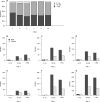Epidemiology of avian influenza A H7N9 virus in human beings across five epidemics in mainland China, 2013-17: an epidemiological study of laboratory-confirmed case series
- PMID: 28583578
- PMCID: PMC5988584
- DOI: 10.1016/S1473-3099(17)30323-7
Epidemiology of avian influenza A H7N9 virus in human beings across five epidemics in mainland China, 2013-17: an epidemiological study of laboratory-confirmed case series
Abstract
Background: The avian influenza A H7N9 virus has caused infections in human beings in China since 2013. A large epidemic in 2016-17 prompted concerns that the epidemiology of the virus might have changed, increasing the threat of a pandemic. We aimed to describe the epidemiological characteristics, clinical severity, and time-to-event distributions of patients infected with A H7N9 in the 2016-17 epidemic compared with previous epidemics.
Methods: In this epidemiological study, we obtained information about all laboratory-confirmed human cases of A H7N9 virus infection reported in mainland China as of Feb 23, 2017, from an integrated electronic database managed by the China Center for Disease Control and Prevention (CDC) and provincial CDCs. Every identified human case of A H7N9 virus infection was required to be reported to China CDC within 24 h via a national surveillance system for notifiable infectious diseases. We described the epidemiological characteristics across epidemics, and estimated the risk of death, mechanical ventilation, and admission to the intensive care unit for patients admitted to hospital for routine clinical practice rather than for isolation purpose. We estimated the incubation periods, and time delays from illness onset to hospital admission, illness onset to initiation of antiviral treatment, and hospital admission to death or discharge using survival analysis techniques.
Findings: Between Feb 19, 2013, and Feb 23, 2017, 1220 laboratory-confirmed human infections with A H7N9 virus were reported in mainland China, with 134 cases reported in the spring of 2013, 306 in 2013-14, 219 in 2014-15, 114 in 2015-16, and 447 in 2016-17. The 2016-17 A H7N9 epidemic began earlier, spread to more districts and counties in affected provinces, and had more confirmed cases than previous epidemics. The proportion of cases in middle-aged adults increased steadily from 41% (55 of 134) to 57% (254 of 447) from the first epidemic to the 2016-17 epidemic. Proportions of cases in semi-urban and rural residents in the 2015-16 and 2016-17 epidemics (63% [72 of 114] and 61% [274 of 447], respectively) were higher than those in the first three epidemics (39% [52 of 134], 55% [169 of 306], and 56% [122 of 219], respectively). The clinical severity of individuals admitted to hospital in the 2016-17 epidemic was similar to that in the previous epidemics.
Interpretation: Age distribution and case sources have changed gradually across epidemics since 2013, while clinical severity has not changed substantially. Continued vigilance and sustained intensive control efforts are needed to minimise the risk of human infection with A H7N9 virus.
Funding: The National Science Fund for Distinguished Young Scholars.
Copyright © 2017 Elsevier Ltd. All rights reserved.
Conflict of interest statement
BJC has received research funding from Sanofi Pasteur. The authors report no other potential conflicts of interest.
Figures




Comment in
-
The changing landscape of A H7N9 influenza virus infections in China.Lancet Infect Dis. 2017 Aug;17(8):783-784. doi: 10.1016/S1473-3099(17)30337-7. Epub 2017 Jun 2. Lancet Infect Dis. 2017. PMID: 28583579 No abstract available.
-
Avian influenza A (H7N9) virus infections in humans across five epidemics in mainland China, 2013-2017.J Thorac Dis. 2017 Dec;9(12):4808-4811. doi: 10.21037/jtd.2017.11.17. J Thorac Dis. 2017. PMID: 29312663 Free PMC article. No abstract available.
References
-
- Gao R, Cao B, Hu Y, et al. Human infection with a novel avian-origin influenza A (H7N9) virus. N Engl J Med. 2013;368(20):1888–97. - PubMed
Publication types
MeSH terms
Substances
Grants and funding
LinkOut - more resources
Full Text Sources
Other Literature Sources
Medical

